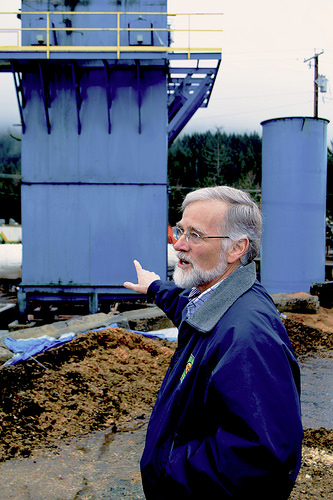
Visitors to USDA’s Farmers Market on Sept. 30, 2016, weren’t playing Pokemon. They were helping with a behavioral economics field study about food choices. (Ken Melton, USDA)
This post is part of the Science Tuesday feature series on the USDA blog. Check back each week as we showcase stories and news from USDA’s rich science and research portfolio.
What were visitors to USDA’s Farmers Market on Friday, Sept. 30, doing with the iPads they were holding? They certainly weren’t playing Pokemon Go! Instead, they were participating in a behavioral economics study about food choices.
The USDA Farmers Market, managed by USDA’s Agricultural Marketing Service (AMS) and located just steps from the National Mall in downtown Washington, D.C., is a “living laboratory” for farmers markets around the country. It’s also a great place to learn about the factors that influence customers’ buying decisions. Read more »
Tags: Agriculture and Food Research Initiative, AMS, behavioral economics, Center for Behavioral and Experimental Agri-Environmental Research, Elanor Starmer, ERS, Farmers Market, food choices, Kent Messer, Mary Bohman, NIFA, Science Tuesday, Washington DC
 Science
Science

Bear Mountain Forest Products plant owner Bob Sourek in Oregon produces BBQ pellets and home heating fuel pellets. Bear Mountain Bear Bricks (similar to firewood logs), and animal bedding are produced at the Cascade Locks facility.
One of the hallmarks of the Obama Administration has been our commitment to economic growth through an expanding bio-based economy. Nowhere is that transformation more pronounced than the success of renewable energy. And USDA Rural Development has been a leader in that effort.
The proof is in the numbers: Domestic energy-related emissions have fallen to their lowest level in 20 years. Our dependence on foreign oil is at a 40-year low and declining. In the last eight years, USDA has helped lead an effort to promote the domestic production and use of advanced biofuels and biobased products, supporting millions of jobs and pumping hundreds-of-billions-of-dollars into the U.S. economy. Read more »
Tags: bio-based economy, biobased, biofuels, Energy, Oregon, RD, REAP, Renewable Energy, Rural America, Rural Energy for America Program
 Energy, Rural Development
Energy, Rural Development

Agriculture Secretary Tom Vilsack, greets military veterans James Youngblood, Staff Sergeant, United States Army, Cari Bains, Staff Sergeant, United States Army, Charles Horton Sr., Master Sergeant, United States Air Force, Jeffrery Dezort, Corporal, United States Marine Corps, Paul Derdzinski, Staff Sergeant, United States Army and Anthony Williams, Sergeant First Class, United States Army comprising the inaugural cohort of the United States Department of Agriculture (USDA) Agricultural Commodity Grader Apprenticeship Program at the USDA in Washington, DC on Mon., Oct. 3, 2016. The program is a Department of Labor (DOL) Registered Apprenticeship providing technical training and professional development to prepare employees to serve American agriculture. After successfully completing the 12-month pilot program, the apprentices will have a nationally recognized Department of Labor Apprentice Accreditation and the skills and training for professional success. USDA Photo by Ken Melton.
Over the last eight years, we’ve seen an increase in the number of veterans turning to agriculture for their post-service career. While many choose farming and ranching, others seek employment in the agriculture industry as well as federal service. USDA employs more than 11,000 veterans, and we’re looking to increase that number through a new apprenticeship program.
The program, which is being launched this week by USDA’s Agricultural Marketing Service (AMS) in partnership with the Department of Labor (DOL) and the Department of Veterans Affairs (VA), is a registered national apprenticeship that will grow a pool of talent for USDA. Although it is open to anyone interested in a career in agriculture, we are especially proud that it offers America’s veterans one more way to join our ranks. Read more »
Tags: Agricultural Commodities Grader, AMS, apprentice, apprenticeship, careers, Department of Defense, Department of Veterans Affairs, Farmers, GI Bill, jobs, Military, transition assistance, U.S. Department of Labor, veterans, Veterans Apprenticeship Program, vocational rehab
 Education
Education

African lions are vulnerable to habitat fragmentation and U.S. Forest Service landscape modeling identified fencing and corridors as suitable solutions in many countries. Photo credit: Sam Cushman
The landscape modeling expertise Samuel Cushman provides as a research ecologist at the U.S. Forest Service’s Rocky Mountain Research Station is in demand worldwide as human-caused disturbances impact animal distribution, connectivity and survival.
Whether it’s clouded leopards in Borneo, lions in Africa, elephants in India, snow leopards in Central Asia or European brown bears, Cushman and his partners study what aspects of the landscape are truly important to animals, how they influence movement and genetic diversity, and which conservation plans will have the most impact. Read more »

Canola is the subject of a rural economic growth project in Western Oklahoma. USDA ARS image
Regional Rural Development Centers (RRDCs) play a unique role in USDA’s service to rural America. They link the research and educational outreach capacity of the nation’s public universities with communities, local decision makers, entrepreneurs, families, and farmers and ranchers to help address a wide range of development issues. USDA’s National Institute of Food and Agriculture (NIFA) provides core funding for RRDCs and integrated research, education, and extension activities.
By Rachel Welborn, project manager with the Southern Rural Development Center at Mississippi State University
How can rural communities compete in an ever-expanding global market?
Rural counties across the country are finding innovative ways to capitalize on their local strengths. Through a guided process, more than 400 counties in 38 states are discovering new ways to work together to grow their economies. Read more »
Tags: Mississippi, Mississippi State University, NIFA, North Carolina, Oklahoma, RD, regional development, Rural Economy, Stronger Economies Together
 Economic Growth, Education, Rural Development
Economic Growth, Education, Rural Development

Wood boring insect pests can continue their development deep within cut wood. They can emerge from wood left to sit outside to infest new areas.
This October, the Nature Conservancy’s Don’t Move Firewood campaign and Hungry Pests, an initiative from APHIS, are partnering to present the first-ever Firewood Awareness Month. The cooler nights and quickly approaching fall season brings an increase in RV camping, hunting, and home heating. Firewood Awareness Month looks to raise public awareness about the potential danger of firewood movement as a pest and disease pathway at this high-risk time of year.
Tree-killing invasive insects and diseases can lurk both inside, and on the surface, of firewood. While these insects and diseases don’t travel far on their own, transporting firewood allows them to move hundreds of miles and start infestations in new places, explains APHIS Deputy Administrator Osama El-Lissy. Read more »






